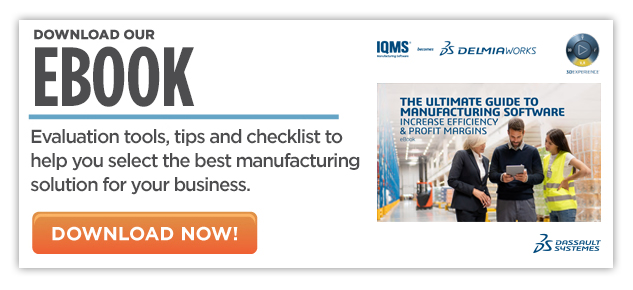The Ultimate Guide to Manufacturing Software
Bottom Line: The majority of manufacturers are prioritizing shop floor productivity as their most valuable growth strategy, relying on manufacturing software to be the catalyst to get them there.
What is Manufacturing Software?
Best defined by its many benefits, manufacturing software provides real-time visibility into the details of a manufacturing operation. With greater visibility, manufacturers attain greater control of daily production, machine yield rates, supplier performance, quality, and ultimately, profit margins.
State-of-the-art manufacturing software interprets and analyzes real-time data from machines running on the shop floor, providing invaluable insights into daily operations. The best manufacturing software focuses on how modules in an integrated system can be orchestrated to improve efficiency, quality, and profits continually.
Look for manufacturing software providers whose main focus is on shop floor control and end-to-end visibility. These two factors are the fuel that enables manufacturing software systems to deliver benefits to your business, a few of which are listed below. They’re achieved by having a manufacturing system that integrates accounting and finance, manufacturing operations, Manufacturing Execution System (MES), production management, and quality management and control all on the same platform.
- Eliminate unplanned downtime
- Prevent bottlenecks in the manufacturing process
- Operate with near 100% machine utilization
- Optimize scheduling and resource allocation regardless of the plant location
- Have complete unimpaired visibility and traceability of the entire manufacturing process from raw material, through customer delivery
- Comply with quality standards
Why Is Manufacturing Software So Hot Today?
- The global ERP software market is expected to grow from $32.6B in 2017 to $61.2B by 2025, achieving a Compound Annual Growth Rate (CAGR) of 8.27% during the forecast period.
- Gartner predicts the ERP market will increase from $31.4B in 2017 to $44.3B in 2022, growing at a CAGR of 7%.
- Spending on Manufacturing ERP software worldwide will increase from $5.87B in 2017 to $7.26B in 2022.
There’s a combination of long-term trends continuing to nurture the growth of manufacturing software. Lead times are becoming shorter, quality and compliance requirements are becoming more complex, and automation is becoming more affordable. The need to compete globally is top of mind for many manufacturers. The long-term labor shortage is also motivating manufacturers to automate more of their operations. All of these factors contribute to manufacturing software growing in importance over the long-term.
A few of the many benefits manufacturing software is providing include the following:
Audits And Compliance
- Audit every step of the production process and provide that data to customers and regulatory agencies by running a report instead of having to tabulate and format it manually.
- Increase the level of compliance through automated reporting.
Customer Relationship Management
- Gain new customers by providing complete, accurate quotes and delivery dates faster than competitors.
- Increase customer satisfaction by meeting delivery dates.
- Reduce order errors by building the right product & delivering on schedule.
Manufacturing Execution System
- Assure every operator on the shop floor has up-to-date training and certifications.
- Better manage shop floor teams by assigning each team member to a process they are excellent at.
- Create and use work instructions that are tested and shared across the shop floor, reducing costly production errors.
- Increase production capacity with existing machines and staff as part of capacity planning.
- Increase the efficiency of shop floor operations and get more done.
- Measure Overall Equipment Effectiveness (OEE) to improve individual machinery performance.
Supplier Quality Management
- Improve inbound supplier quality and measure how that improves production efficiency.
- Improve supplier quality levels, so production isn’t delayed.
- Use supplier data to improve supplier selection and evaluate their performance to goals.
- Improve overall product quality.
Production Scheduling
- Update production schedules in real-time instead of only a few times a week.
- Find out which areas of manufacturing operations need attention before a problem occurs.
- Improve inventory management and costs.
Conclusion
By providing real-time visibility and control, improving communication, and enabling greater collaboration across production locations, manufacturing software is digitally transforming manufacturing today. Be sure to get a copy of the ebook, The Ultimate Guide to Manufacturing Software: Increase Efficiency & Profit Margins to learn more about the many advantages of manufacturing software, how to evaluate manufacturing systems including key questions to ask. The ebook also provides a needs assessment and requirements gathering section to help you select the best manufacturing software for your organization.




